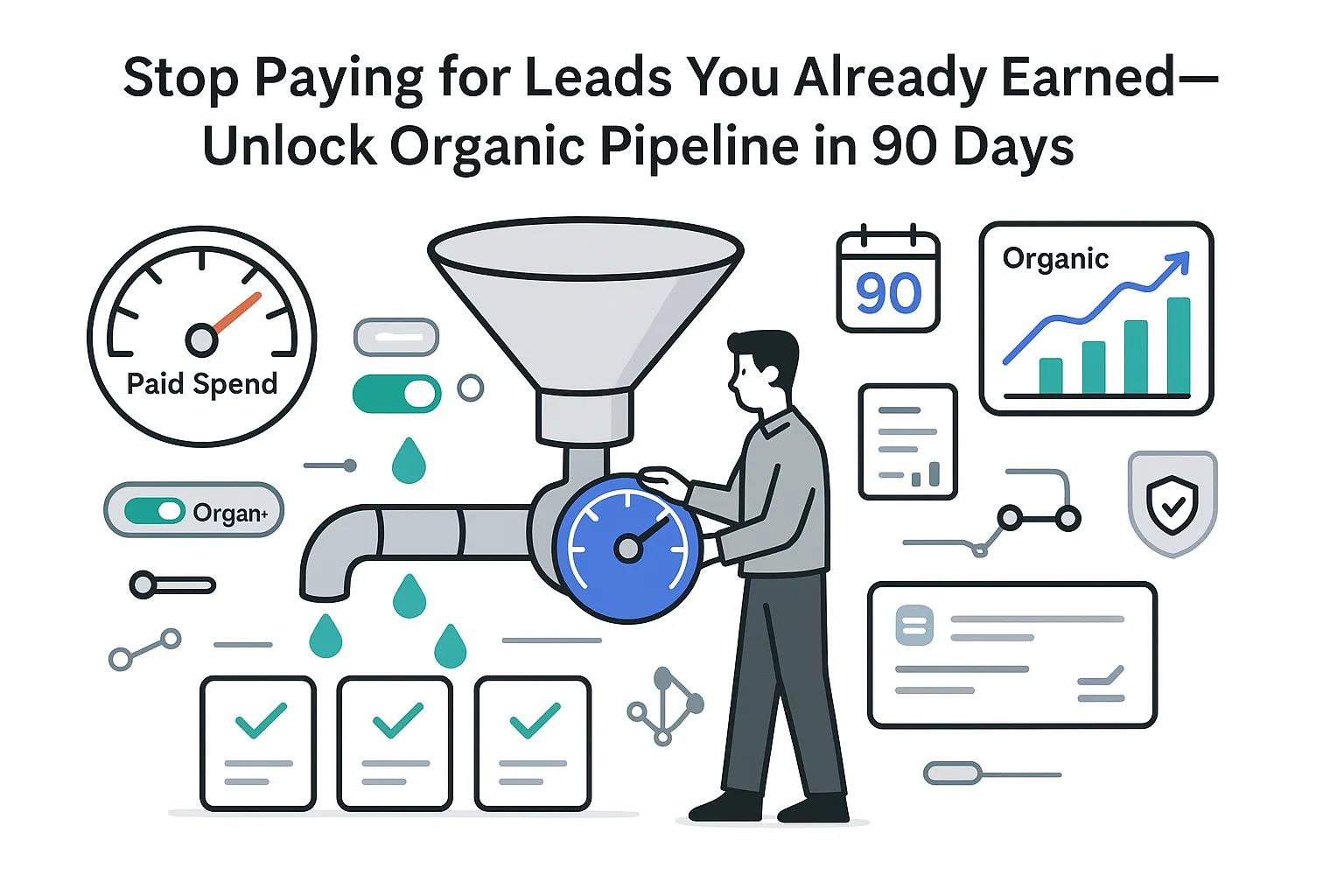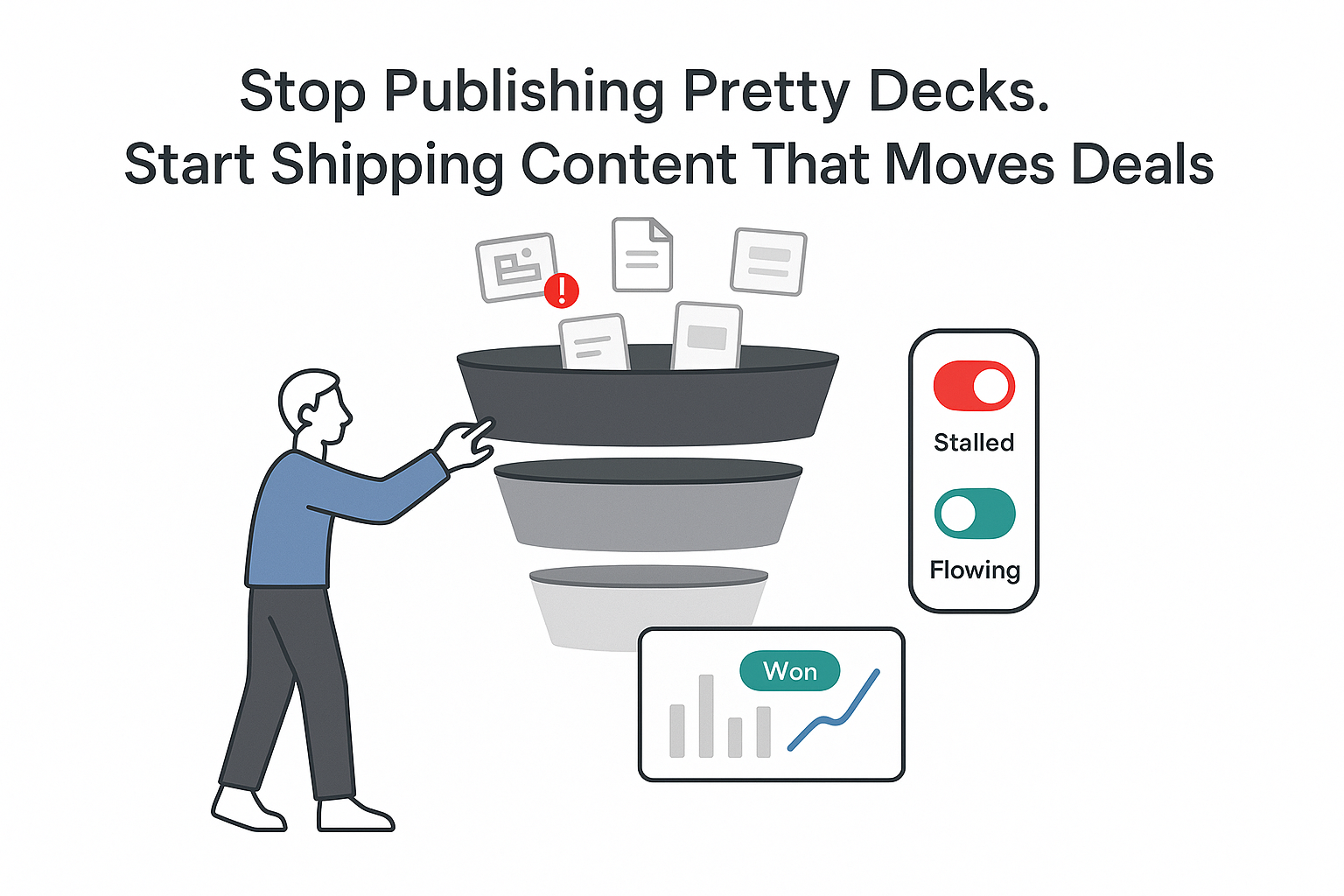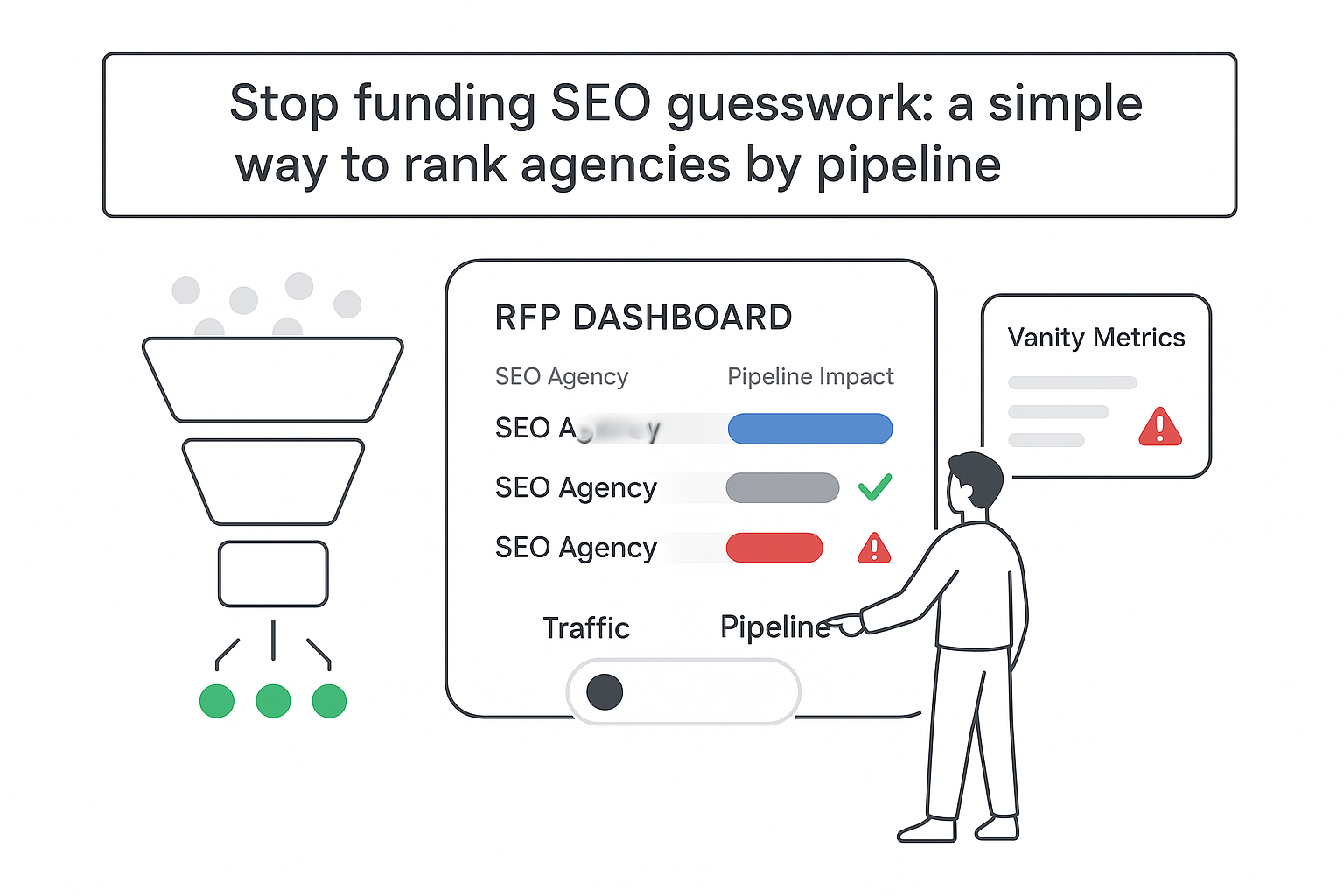Growth stalls feel personal. I know there is more demand out there, yet every extra dollar into paid brings thinner margins and twitchy attribution. On paper, I want something simple: a faster, cleaner pipeline I do not have to babysit. That is exactly where a predictable B2B search program shines when it is designed for service companies and measured against revenue.
Abstract: best SEO agency for B2B service companies
If you are a CEO of a B2B services firm, you care about two things right now: more qualified pipeline fast, and less micromanaging. A tight ninety-day SEO sprint can move both. When the work is anchored to revenue, I typically see earlier discovery on high-intent pages, better conversion paths, and reporting that ties content to opportunities, not vanity charts.
A typical 90-day outcome snapshot for firms between 50K and 150K in monthly revenue (directional; outcomes vary by ACV, baseline, and sales capacity):
- +25% to +60% growth in organic MQLs recorded in the CRM
- MQL-to-SQL rate lift of 3 to 7 points from cleaner intent targeting
- 2 to 6 net-new qualified opportunities sourced by organic, with a projected pipeline value uplift of 80K to 300K, depending on ACV and sales cycle length
Visual: imagine a 90-day traction mini-dashboard with four tiles: Organic MQLs, SQL conversion, Opportunities opened, Pipeline value sourced.
How buyers search across the funnel
I map topics to how real buyers search when they have a job to be done. Across stages, the queries look like this:
- Top of funnel: B2B SEO strategy, thought leadership topics, industry benchmarks for service firms
- Consideration: SEO for service-based businesses pricing models, technical SEO considerations for B2B, content clusters for long sales cycles
- Decision: best SEO agency for B2B service companies, B2B SEO case studies, SEO contract terms for services
- Bottom of funnel: B2B lead generation content ideas, SEO attribution in CRM, organic pipeline forecasting
- Post-purchase enablement: content refresh cadence, link earning via partnerships, governance framework for SEO
Why SEO fits service-based businesses
Paid channels do a great job when speed matters. They also raise blended CAC and hit a ceiling in crowded markets. Organic search changes the math by adding a compounding inbound engine that keeps working after you stop paying for the click. Not hype. Just compounding.
If you are skeptical about timelines or the noise you have heard before, that is fair. The fix is predictable execution tied to the way B2B services actually sell. I focus on intent-driven keywords mapped to business problems, pages that convert into conversations, and a reporting line that ends in your CRM. When the work is framed this way, SEO complements paid, smooths CAC, and lets you scale with fewer surprises.
Service deals cross multiple desks. A researcher starts the query, a manager builds a shortlist, and a director or CFO signs off. These buyers read, compare, and verify. Organic matters because it is always available when questions arise, and it meets different stakeholders with the right detail at each step. Lead quality changes too: searchers landing on bottom-of-funnel pages convert at higher rates and progress faster when content addresses real objections pulled from sales calls.
Visual: a simple buyer journey from problem discovery to vendor shortlist, with SEO touchpoints labeled across research, comparison, and validation.
Economics and common failure modes
Let us talk money. Paid CAC is immediate but rises with competition. Organic CAC starts higher because of setup and content work, then falls over time as pages rank and earn links. Over six to twelve months, the blended CAC drops because new demand arrives without a bid attached.
Where teams often miss:
- Vague promises, weak forecasting, and no link to revenue metrics
- Content that targets terms buyers do not use or that sales cannot use in the field
- Ignored technical debt that slows crawling and indexing
- Reporting that stops at traffic instead of tracking to opportunity creation
There is also a market gap hiding in plain sight. When I review share-of-voice for ICP pain terms, I often find competitors owning page one on high-intent queries while the brand sits on page two. That is lost pipeline. Closing those gaps first - before chasing broad topics - is where the early wins live.
Visual: a share-of-voice chart that contrasts your domain with two rivals across priority keywords, paired with a funnel quality view that highlights conversion lift from bottom-of-funnel pages.
A phased, accountability-first program
Here is how I structure SEO for B2B services so it balances quick wins with foundation work and ties every task to a metric owner.
1) ICP-driven keyword research and intent clustering
- Inputs: buyer conversations, CRM win/loss reasons, competitor SERP gaps, search-query data
- Outputs: an intent map by funnel stage, keyword-to-page routing, and a priority score by potential pipeline
2) Technical audit and fix sprint
- Targets: crawl waste, index bloat, slow templates, redirect chains, duplicate titles, schema gaps
- Outputs: a fix backlog with severity, ownership, and acceptance criteria, then implemented changes
3) Content velocity with topic clusters and BOFU-to-MOFU balance
- Mix: 40% bottom-of-funnel comparison and solution pages, 40% mid-funnel guides tied to business problems, 20% executive-level POVs that sales can share
- Outputs: a 90-day editorial calendar, brief library, and structured templates for messaging and schema
4) Conversion architecture and measurement
- Actions: align offers to pages, configure event tracking, and ensure attribution flows from first touch to opportunity
- Outputs: page-level conversion tracking, lead scoring tied to behaviors, dashboards that make sense
5) Authority building through digital PR and partnerships
- Focus: useful research, partner content with real value, and assets that earn links without gimmicks
- Outputs: a target list, outreach themes, quality standards, and measured impact on authority
6) Governance, cadence, and scorecards
- Rituals: weekly scorecard review, biweekly roadmap checks, monthly KPI readouts with a pipeline view
- Metrics with owners: crawl health, index coverage, priority rankings, page-level conversion, organic pipeline opened
- Documentation: a live playbook that records decisions so the machine keeps running
Thirty, sixty, ninety-day deliverables (directional):
- Day 30: completed intent map, top template fixes live, 4–6 bottom-of-funnel pages published, baseline dashboards in analytics and CRM
- Day 60: cluster content shipping at 4–8 pieces per month, first authority placements live, conversion paths tested on priority pages
- Day 90: early rank movement on priority terms, first organic opportunities opened, refresh queue started, and a scorecard showing contribution to pipeline
Visual: a simple 90-day roadmap with weekly lines of work and a KPI tree that links each activity to traffic, conversions, and pipeline.
What results look like and how I validate them
Data beats claims. Here are anonymized snapshots that mirror what B2B services firms see when execution is tight. Figures are directional and depend on ACV, sales cycle, and total addressable search.
-
Cybersecurity services, mid-market focus
- Baseline: 8K monthly sessions with 2.4% lead conversion, 12 MQLs per month, no tracked organic opportunities
- Month 3: 10.4K sessions, 3.7% conversion, 31 MQLs, 4 SQLs, 2 opportunities opened
- Month 6: 15.7K sessions, 4.1% conversion, 54 MQLs, 13 SQLs, 6 opportunities, pipeline value 420K
- Month 12: 28.3K sessions, 4.5% conversion, 115 MQLs, 31 SQLs, 14 opportunities, pipeline value 1.3M
-
Engineering consulting, enterprise accounts
- Baseline: 2.1K monthly sessions, 0.9% conversion, 5 MQLs, high ACV with slow cycles
- Month 3: 2.8K sessions, 1.6% conversion, 12 MQLs, first opportunity at day 72
- Month 6: 4.2K sessions, 2.2% conversion, 27 MQLs, 6 SQLs, 3 opportunities worth 900K combined
Time to first opportunity matters. In most service categories, it appears between week 8 and week 14 when bottom-of-funnel and case pages start ranking or win featured positions.
How I validate impact:
- Attribution: first-touch and assisted views in web analytics, multi-touch in the CRM, plus manual checks against call notes
- Controls: avoid changing paid budgets during the first 60 days if possible, or at least log changes; tag shipped content so gains can be tied to releases
- Counterfactuals: compare trend lines to a pre-period with similar seasonality and to non-priority pages that did not change
Example ROI math
- Input cost for 3 months: 45K across strategy, content, fixes, and PR
- Output: 6 opportunities opened by organic, 2 closed at 120K ACV each, plus 2 in late stage valued at 180K combined
- Recognized revenue: 240K closed-won
- Simple payback in period: 240K ÷ 45K ≈ 5.33x before the remaining pipeline converts
Visual: a before-and-after pipeline chart showing new opportunities by source, plus a small ROI box that walks through the math above.
Managing cost, risk, and accountability
Paid brings speed but keeps charging rent on every click. Organic requires front-loaded work, then lowers marginal cost per lead as pages gain authority. Over six to twelve months, the mix gets healthier as CAC smooths.
Risk management is part of the job. Algorithms shift. Competitors publish. Content decays. Here is how I keep footing:
- Hedge with a healthy spread of bottom, mid, and top-funnel assets so a single update does not knock out your pipeline
- Refresh high-value pages every 90–120 days with new proof, quotes, and updated stats
- Track competitors new pages and links with simple alerts, then respond with better information, not noise
- Protect technical health with ongoing monitoring; broken pages and slow templates will drain gains
Accountability keeps everyone honest. I use OKRs tied to revenue and assign one owner per metric: crawl health, index coverage, priority rankings, page conversion, and pipeline opened. I review a weekly scorecard. If a number goes red, the owner posts the fix plan. Simple, human, clear.
Sales Ops and RevOps are not extras. They unlock the link between content and revenue. A shared naming convention for campaigns, a clean lifecycle from MQL to SQL in the CRM, and consistent lead disposition notes will save months of confusion. If SDRs book meetings from content, tag those campaigns. If AEs close a deal that engaged a comparison page, attach the touchpoints. Then your board deck can show how organic earned its seat.
Visual: a cost curve that drops over time for SEO next to a flat paid line, plus a small RACI box that shows who owns which metric.
Timeline you can trust and what is next
Why this approach works for B2B services: it focuses on intent, fixes the site, ships content that answers real buying questions, earns authority with real partners, and keeps everyone accountable to revenue. You also get compounding gains that lift your pipeline without constant spend increases.
A pragmatic timeline
- Weeks 1–4: research, intent mapping, tech fixes on key templates, first bottom-of-funnel pages live, analytics clean-up
- Weeks 5–8: content velocity across clusters, first authority placements, conversion paths refined, dashboards aligned to CRM
- Weeks 9–12: early rank gains on priority terms, first organic opportunities open, refresh plan started, scorecard trends move from yellow to green
- Months 6–12: compounding shows up at the pipeline level, bottom-of-funnel coverage expands, organic takes a larger share of revenue
If I were prioritizing today, I would document ICP problems, compare SERPs on those problems, and map 10 high-intent pages that should exist but do not. I would fix what blocks crawling and conversion, ship the pages, and wire analytics to the CRM. Then I would watch the story unfold in pipeline charts.
What is ahead
- AI-assisted content ops that speed briefs, structure, and updates without losing editorial judgment
- Query-aware refresh that uses search trends and call transcripts to keep pages current
- Intent data enrichment inside the CRM so sales can act on the right visitors at the right time
Visual: a clean timeline showing weeks 1 to 12 with milestones, then months 6 to 12 with compounding markers.
Final thought: the best SEO agency for B2B service companies is the one that takes ownership of outcomes, speaks in pipeline, and builds a machine your team can keep running. When the focus is that clear, growth feels less like a gamble and more like a plan you can trust.







.svg)